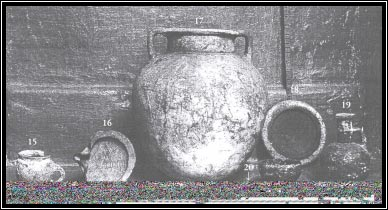This article will deal about three tombs discovered in Mellieħa during the late 19 th and early 20 th centuries. Although the archaeological reports that were made in that period stated that these tombs were discovered at Mellieħa, they did not say where exactly they were found. Therefore, I felt that it was better to write something about them in one article
First tomb
Before the 1890s, a Phoenician rock-cut tomb was found on the hill right of the parish church. Archaeologist A.A. Caruana stated that tombs were located in this
area, which consisted of one cluster, or catacombs. He said that the tombs had several chamber with arched entrances arranged over three stories. Unfortunately the exact place of the site was not indicated in the report, so today no one exactly where it was this tomb.1

Second tomb
In 1912 another Phoenician rock-cut tomb was discovered at Mellieħa, but the place was not indicated. It seems that the tomb was destroyed because there were no dimensions of the tomb and only a complete report of the artefacts found was done. A variety of artefacts were found in this tomb. These included a cinerary urn of unique shape for Malta and it is wide, have tall neck with handles from rim to shoulder. Another artefact is a globular round-mouth jug, apparently red-slipped and burnished. Unfortunately the lip was broken when it was recovered.2
The third object recovered was a two trefoil-mouth, piriform jugs. Another item was a hemispherical bowl, which apparently is thin-walled and red-slipped and burnished. The fifth artefact is a bowl with everted wide rim and possibly red-slipped interior. The sixth item is a small open pot with low-slung handle, a knob on opposite shoulder and rim which is low and slightly low. Another item is a single-spouted lamp and the last one is a small plate.
It seems that the tomb was cut between 1000 to 600 BC, because the pottery artefacts came from this period of Phoenician colonisation of the Maltese islands.3
Third tomb
The third and last Phoenician rock-cut tomb to be found in Mellieħa, exactly on the eastern cliffs facing the village, was discovered 9 March 1929, when workers accidentally broke into a grave. It was immediately reported to the Mellieħa Police and the latter informed immediately the Museums Department. When the archaeologists arrived on the site they found that the tomb was practically destroyed. It was found that no shaft could be made out, part of the burial chamber was also destroyed and the rock was so friable that was hardly distinguishable from the surrounding dry soil.4
The entrance to the burial chamber was 1.2 metres high and 1.1 metres wide. The chamber had an oval plan but partly decayed and probably had a measurement of 1.2 metres height, 1.2 metres wide and a length of 3 metres. A water amphora measured 0.6 metres with tapering base and two handles on shoulders, one conical jar with flat base measured 0.3 metres, and two plates with a diameter of 0.15 metres were recovered. Apart from these artefacts the broken bones of a skeleton of an adult were recovered.
Again it seems that this tomb was cut between 1000 to 600 BC, but this time this theory is based mainly on the oval shape of the chamber.5
References:
1 Claudia Sagona, Ancient and Eastern Studies: The archaeology of Punic Malta, Peetars, Belgium, 2002, p 853.
2. Ibid.
3. Ibid.
4. Government of Malta, ‘Archaeological Section’, Museum Annual Report 1928-29.
5. Sagona, p 853.
Researched and Written by: Charles Debono B.A.(Hons) History